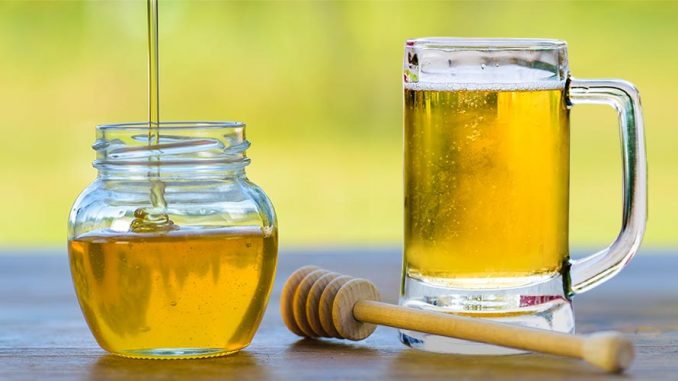
Why Honey?
So why add honey to your homebrew? Well luckily as homebrewers we are not under the same constraints as commercial craft brewers. We don’t have to worry about variability or getting massive amounts of honey. Granted, even on a small scale honey can be somewhat expensive, but there are things you can do to lessen the cost, which I’ll get into further down.
An often quoted fact about beer compared to mead is that it’s more nutritious, but what never seems to be mentioned is if honey is handled with minimal heating, mead is almost assuredly more medicinal. Honey is made up of 95% fermentable sugars (fructose and glucose), a percentage of identified plant and mineral compounds, and a percentage of unidentified compounds. It contains a plethora of enzymes, organic acids, trace minerals, and antimicrobial compounds. A search of the internet will find a number of amazing health studies done with honey. In short, honey is a living food.
If this alone doesn’t get you excited there are some less health-oriented, more brew-oriented reasons for using honey. When added to beer, much like any other simple sugar, it will raise the alcohol level and lighten the body. It can also add flavorful sweetness if desired. In many cases honey will ferment completely away, leaving no residual sweetness — remember 95% fermentable. But if enough is used, and treated in the proper way it can leave subtle sweetness behind. A brewer can even go as far as defining the sweet character by the type of honey used.
Raw or Pasteurized
Brewers tend to make a big to-do about the need to pasteurize honey before fermenting. The old rule was to add it to the boil. Others say lower temperature pasteurization is all that’s needed. The thinking behind both of these approaches is to kill off any wild yeast and bacteria living in the honey. Problem is heating honey destroys much of the fragile aroma and flavor compounds. It also kills most of the “good stuff” in the honey. Honey is antibacterial, so the chance of bacteria being a problem is minuscule.
If you’re afraid of wild yeasts or bacteria you can pasteurize it yourself. There are several different methods, temperatures, and time lengths written about around the internet. Your first and easiest option is adding it during the boil.
The other most quoted way is to hold the honey at 176°F for up to two hours. There are two ways to do this. You can place the honey in a baking pan in the oven, stirring and checking the temperature once in a while. It can also be done by diluting the honey with water in a lidded saucepan to the same gravity as your wort, and holding it at 176°F on the stovetop. After the time is up cool the honey or honey-water dilution down to fermentation temperatures as fast as you can.
If you are comfortable pasteurizing at a lower temperature and/or for less time, go for it, but do what you have to do to be comfortable with adding the honey to your brew.
The Mash
If the yeast ferments out all the sugar provided by the honey it is likely you will end up with a thin bodied beer. To avoid this, all-grain brewers can raise their mash temperatures into the upper range of the brewer’s window, 155°F to 158°F. This favors the enzyme alpha amaylase, which creates more non-fermentable sugars, adding perceived body to the beer.
Extract brewers may want to add 6 to 8 ounces of maltodextrin to help increase body.
How Much Honey?
How much honey you use is going to depend on the variety and how much honey characteristic you want in your finished beer. Honey varieties vary in both water content and sweetness, so the gravity points honey adds is variable.
What percentages are we looking at using in our brew?
3-10% — A subtle flavor is contributed to the ale or lager. Most commercially available honeys such as clover, alfalfa, orange blossom, sage and mixed wildflower are very mild in aromatic flavor intensity.
11-30% — A distinctly noticeable honey flavor note will develop. Stronger hop flavors, caramelized or roasted malts, spices or other ingredients should be carefully considered when formulating recipes to balance stronger honey flavors at this higher level.
More than 30% — The flavor of the honey will likely dominate the other flavors in the beer. The beverage should probably be considered in a category of its own.
Generally, honey varieties will have a specific gravity between 1.032 and 1.040. Many brewers will use a number somewhere in the middle of that range for all honey calculations, say 1.037, and never get anymore exact. You could even vary the number slightly just by the perceived quality of the honey; lower quality honey will likely have more water content and thus a lower specific gravity than higher quality. In most cases this will get you close enough to your desired original gravity to make little difference.
If you plan to use a specific honey a lot you may want to get a more exact specific gravity. Remember specific gravity is a measurement of points per pound per gallon, so you could dilute a pound of honey into a gallon of water and take a gravity measurement. Off course, this wastes honey (though I do hope you’d brew with the dilution).
To avoid any waste you can scale this down to 2 cups final volume and 2 ounces of honey. There are 16 cups in a gallon, so 2 cups is 1/8th of a gallon and there’s 16 ounces in a pound so 2oz. is 1/8th of a pound. Either way you do it you’d have a gravity reading for that specific honey.
Once you have the specific gravity of the honey, whether calculated or assumed, you can figure out how many gravity points a pound of the honey will add to your wort. Remember, specific gravity is basically gravity points with a 1.0 tacked on so 1.037 specific gravity equals 37 gravity points.
So, let’s apply this to a beer. There are two ways to do this depending on whether you are adding the honey directly to a full volume batch or diluting the honey into a volume of water and then using this volume to bring your wort to the desired batch size.
1. Adding Honey Directly:
Say you’ve brewed a 5 gallon batch of cream ale at 1.045 and now you want to add enough honey to top it out at an original gravity of 1.055.
- First, we calculate the gravity points in your projected original gravity — (5 x 55) = 275
- Then, calculate the present gravity points in your 5 gallons of wort — (5 x 45) = 225
- Subtract to get the points that will come from the honey — 275 – 225 = 50
- Divide by the gravity points of a pound of honey — 50 / 37 = 1.35 lbs. of honey needed.
This fits pretty closely with the general notion that a pound of honey adds roughly 1.007 to 1.0075 to the specific gravity of a 5 gallon batch of beer.
2. Diluting to Original Gravity:
This method is accomplished by brewing a smaller wort and topping it off either in the boil or fermenter with a volume of honey-water at the same specific gravity as the wort. If using this method to add honey after fermentation is started, dilute the honey to the fermentation’s present specific gravity.
Let’s look at the same beer as above. You’ve brewed your cream ale, but this time to a volume of only 4 gallons at the original gravity of 1.055.
You want to dilute the right amount of honey into one gallon of water to bring it up to the same gravity. In our sample case, one pound of honey will raise the gravity to 1.037.
- Subtract: 55-37 = 18 gravity points left.
- Divide: 18 / 37 = 0.48 or around half a pound of honey. So 1.5 pounds of honey dissolved in one gallon of water will give a specific gravity close to 1.055.
If you had 3 gallons of wort and 2 gallons of honey water that first pound would give a gravity of 1.017, half of what it would in one gallon of water. In two gallons you’d need twice as much honey to bring it up to the same gravity.
Adding The Honey
There are several places you can add the honey. The final results can vary drastically between some of these methods.
-
In the Boil:
Pasteurizes the honey. Few if any flavor/aroma compounds will remain, kills the “good stuff.” Use this approach if you don’t care about having the aroma or flavor making up a part of the beer’s final character and you’re only using the honey as a sugar source to bump up starting gravity and/or thin out your beer.
-
At Flame Out:
Pasteurizes the honey, kills the “good stuff,” but theoretically leaves more flavor/aroma compounds. Can be used if you feel boiling the honey is overkill and you are looking to possibly have traces of the honey’s flavor and aroma in your finished beer. Note that even this approach will not preserve much of the volatile compounds.
-
In the Fermentor at High Kraeusen (Peak Yeast Activity):
Will not pasteurize the honey. Adding the honey 2 to 4 days into fermentation gives the yeast time to work on the complex maltose sugars provided by the malt before turning to the simple sugars. There is a slight chance of the yeast tiring before all the maltose is dealt with if honey is added any time before high kraeusen.
-
In the Fermentor as Fermentation Ends:
Will not pasteurize the honey. Adding honey here will preserve more of its sweet character and faint flavor and aromatic qualities.
-
In the Secondary:
Will not pasteurize the honey. Adding honey here will likely preserve the highest amount of honey character.
We recommend don’t pasteurize at all, so the only place to add the honey is during fermentation with no beforehand heating whatsoever. I either start with a smaller volume brew and bring it to full volume by topping it off with a honey-water dilution at the same gravity; or I simply warm the container of honey in a pan of water on the stove — so it flows easily — and add it directly to a full volume/lower gravity fermentation.
And again, do what you’re comfortable with.
Takeaways
There is much to be discovered at the crossroads where brewing and honey meet. The huge selection of honey varieties coupled with the innumerable variations in brewing technique, yeast strains, hop varieties, and malt bills makes for endless experimentation. So, look to the bee and his humble honeyed work the next time you’re looking for an easy sugar source to stick into your newest recipe.
Happy Brewing!
Original post by: learn.kegerator.com

Leave a Reply
You must be logged in to post a comment.